On December 31, China alerted the
World Health Organization (WHO) to several cases of pneumonia in Wuhan, a
port city of 11 million people in the central Hubei province. The virus
is unknown.

Several of those infected worked at the city's Huanan Seafood Wholesale Market, which was shut down on January 1,2020
As health experts worked to identify the virus amid growing alarm, the number of infections exceeded 40.
On January 5, Chinese officials ruled out the possibility that this was a recurrence of the severe acute respiratory syndrome (SARS) virus - an illness that originated in China and killed more than 770 people worldwide in 2002-2003.
On January 7, they announced that they had identified a new virus, according to the WHO. The novel virus is from the coronavirus family, which includes SARS and the common cold, and is named 2019-nCoV. Coronaviruses are common and spread through coughing, sneezing, or touching an infected person
On January 11, China announced its first death, a 61-year-old man who had purchased goods from the seafood market. Treatment did not improve his symptoms after he was admitted to hospital and he died on the evening of January 9 when his heart failed.
On January 13, WHO reported a case in Thailand, the first outside of China, a woman who had arrived from Wuhan.
On January 16, Japan's health ministry reported a confirmed case, a man who had also visited the city.
On January 17, as a second death was reported in Wuhan, health authorities in the United States announced that three airports would start screening passengers arriving from the city.
Authorities in the US, Nepal, France, Australia, Malaysia, Singapore, South Korea, Vietnam and Taiwan confirm cases over the following days.
On January 20, China reported a third death and more than 200 infections, with cases also reported outside Hubei province including in the capital, Beijing, Shanghai and Shenzhen.
On January 22, the death toll in China jumped to 17 with more than 550 infections. Many European airports stepped up checks on flights from Wuhan.
Wuhan was placed under effective quarantine on January 23 as air and rail departures were suspended.
The same measures were announced for two more cities in Hubei province, Xiantao and Chibi.
Beijing cancelled events for the Lunar New Year starting on January 25, while officials reported the first death outside of Hubei.
The WHO said later on January 23 that the outbreak does not yet constitute a public emergency of international concern and there is "no evidence" at the moment of the virus spreading between humans outside of China.
By January 24, the death toll in China stood at 26, with the government reporting more than 830 infections.
The number of cities under shutdown in Hubei rose to 13, affecting 41 million people.
Shanghai Disneyland shut down and some cities announced the closure of entertainment venues. Beijing said a section of the Great Wall and other famous landmarks would also be closed.
On January 25, travel restrictions were imposed on a further five cities in Hubei province, taking the overall number of people affected to 56 Million
Hong Kong meanwhile declared a virus emergency, cancelled Lunar New Year celebrations and restricted links to mainland China.
On January 26, the death toll rose to 56, with almost 2,000 cases confirmed as travel restrictions were increased and Hong Kong closed its Disneyland and Ocean Park theme parks.
New cases were confirmed in the US, Taiwan, Thailand, Japan and South Korea.
As of January 27, the death toll in China had risen to 106, with 100 in Hubei province, authorities reported. Another 4,515 people in China had been infected. There were 2,714 confirmed cases in Hubei province, up from 1,423 the day before

No comments:
Post a Comment